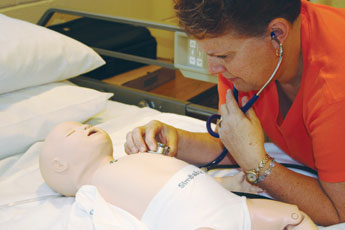
| College Announces Arrival of SimBaby |
||
|
Carroll Community College is pleased to announce the arrival of SimBaby, an infant-sized patient simulation mannequin that allows nursing and allied health faculty to train students in a realistic setting. SimBaby, weighing in at 9 pounds and only three months old, arrived at the Nursing and Alllied Health Building in April. The purchase of the training tool was funded through dollars raised from the college’s Major Gifts Campaign, which entered its public phase last fall. SimBaby was purchased for $33,657. “I consider SimBaby a wonderful asset that will contribute to advanced learning, and the development of skills, for our nursing and allied health students,” said college President Dr. Faye Pappalardo. The infant mannequin, sold by Laerdal Medical, simulates a baby’s vital signs, has heart sounds, breathing sounds, and bowel sounds. SimBaby also cries and whimpers. SimBaby can produce a newborn’s irregular breathing pattern, or can show respiratory distress. The mannequin’s lips can also turn blue, like a baby who has cyanosis due to lack of oxygen. “It is not unusual for community colleges, four-year colleges, or teaching hospitals to own a patient simulation mannequin for students to practice their skills in a safe environment,” said Nancy Perry, R.N., M.S., C.N.E., director of the Nursing Program at Carroll. “SimBaby allows students to fully develop their assessment skills and learn what it is like to work in real-world health care settings. This is especially important in a registered nursing program,” said Perry. The bodily actions of the mannequin are programmed by a faculty member using a computer connected to it. The computer monitor even has a camera that does video recordings of students so that faculty can remotely watch how students perform. The computer also records actions taken by students in response to simulated medical conditions. SimBaby joins a family of two other patient simulation adult patients called SimMan. Treated as either a male or female patient with problems specific to each, SimMan first arrived at the college in fall 2004 to christen the new Nursing and Allied Health Building, and arrived again in spring 2005. SimMan works in a similar way as SimBaby, but is not as technologically advanced as its smaller counterpart. However, since SimMan simulates the adult patient, it can speak in words and sentences. It also weighs 75 pounds, an intentional feature of the mannequin that helps students learn how to work with a patient who cannot lift himself. “As students advance through the program, faculty members use SimBaby to create an adverse scenario to test student’s reactions and problem solving skills,” said Perry. A VitaSim mannequin housed in the facility is a less sophisticated version which produces only vital signs. The family of patient simulation mannequins is used by students in credit programs, including students studying to become registered nurses, licensed practical nurses, and physical therapist assistants. Students in non-credit programs studying to become certified nursing assistants primarily work with VitaSim.fter 16 years of teaching biology at Carroll Community College, Associate Professor Sarah Sayre believes she is leaving behind the “most exciting field of all.”
Nursing program director Nancy Perry checks on SimBaby’s condition. |
||
